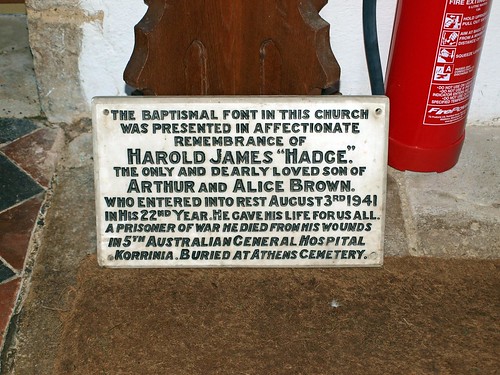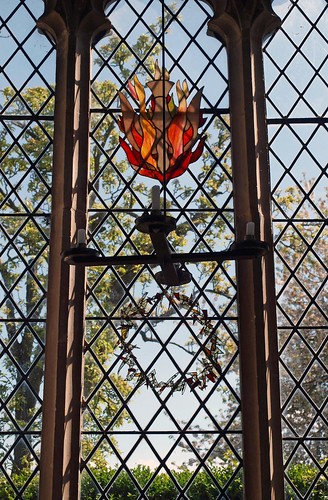ST PETER. The nave has a Norman N arcade, but above it appear the traces of two Norman windows from the time before the arcade was built. The arcade is later C12. Round piers, cruciform multi-scalloped capitals, one-step arches with two tiny chamfers. The W bay was rebuilt when the tower was built, but the Norman pier shows that such a bay had existed already in the C12. Norman also the chancel arch, depressed rounded. In the chancel N and S walls a long round-headed lancet, i.e. late C12. The tower is late C13, see the bell-openings with two sub-arches on a polygonal shaft. To the W a small Dec niche with a kneeling figure and a soul in a napkin. The S arcade is ambiguous. The arches are C13, but the capitals Perp. - (FONT COVER. Jacobean, with nicely decorated ribs. GMCH) - SCREENS. Modest screens of one-light divisions to chancel and N chapel. - STAINED GLASS. In two S aisle windows good C15 canopies. - PLATE. Spanish silver-gilt Dish ornamented in repoussé, the centre engraved with an Annunciation, partly enamelled. Early C15. - Cup and Cover Paten 1613-14. - MONUMENTS. Tablet to Peter Phesaunt d. 1649, still Elizabethan in style. Latin inscription. - Tablet to Sir Richard and Lady Bickerton. She died in 1811. Urn above inscription.
UPWOOD. It seemed all cottages and haystacks, we thought, except for Upwood House in its small park, its walls and its big chimneys much as they were 250 years ago.
But we found in its church one of the most beautiful small things that ever left Spain, an alms-dish about nine inches wide, the masterpiece of a craftsman who died long before they brought his countryman Columbus home in chains. It has an engraving of the Annunciation, and in its two wonderful borders is elaborate ornament showing strange animals among leaves.
Here, in memory of one of King Charles’s judges, is a pheasant perched above his coat-of-arms, for his name was Peter Phesaunt. He must have seen the carpenters making the roof over the chancel in the first year of the Civil War; he would hear them talking of the bad times they were living in, though none of them would dream of the king walking out to die. The church has two Norman windows in the chancel, three Norman arches in the north arcade, and a queer chancel arch looking as if it had been pushed out of shape in the 800 years since they left it. The roofs of the nave and the aisle have tracery carved before an Englishman had seen a printed book, and there are a few bench-ends of the same century. The font is 500 years older than the 17th century pyramid which covers it. The chancel has a magnificent screen with seven bays between panels, and there is a smaller screen in the north aisle, both the work of 15th century men.
Much later is a roughly carved altar table and a money chest. A little old glass in two windows is 15th century, the fragments showing oak leaves and small figures. A kneeling figure and a lady in a wimple have looked out on the churchyard since King John’s day.
But we found in its church one of the most beautiful small things that ever left Spain, an alms-dish about nine inches wide, the masterpiece of a craftsman who died long before they brought his countryman Columbus home in chains. It has an engraving of the Annunciation, and in its two wonderful borders is elaborate ornament showing strange animals among leaves.
Here, in memory of one of King Charles’s judges, is a pheasant perched above his coat-of-arms, for his name was Peter Phesaunt. He must have seen the carpenters making the roof over the chancel in the first year of the Civil War; he would hear them talking of the bad times they were living in, though none of them would dream of the king walking out to die. The church has two Norman windows in the chancel, three Norman arches in the north arcade, and a queer chancel arch looking as if it had been pushed out of shape in the 800 years since they left it. The roofs of the nave and the aisle have tracery carved before an Englishman had seen a printed book, and there are a few bench-ends of the same century. The font is 500 years older than the 17th century pyramid which covers it. The chancel has a magnificent screen with seven bays between panels, and there is a smaller screen in the north aisle, both the work of 15th century men.
Much later is a roughly carved altar table and a money chest. A little old glass in two windows is 15th century, the fragments showing oak leaves and small figures. A kneeling figure and a lady in a wimple have looked out on the churchyard since King John’s day.



No comments:
Post a Comment